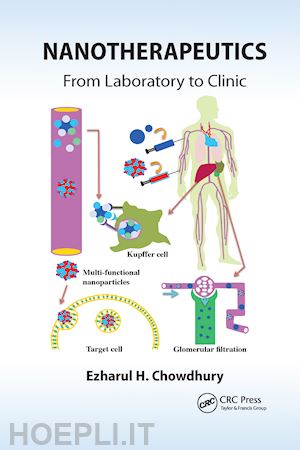Emergence of nanotherapeutics: Challenges in classical drug transport versus macromolecular drug designAdministration of small-molecule drugs: Traffic routes toward the bloodstreamFates of the small-molecule drugs in bloodMajor problems associated with traditional formulations of small-molecule drugsAlteration of pharmacokinetics of small-molecule drugs with macromoleculesProtein-based macromolecular drugsDNA/RNA-based macromolecular drugsMacromolecules for prodrug therapyMacromolecules for vaccine deliveryNanoparticles for photodynamic therapyMacromolecules for image-guided drug deliveryThe ultimate destinations for delivery and release of nanotherapeuticsSustained-release formulationsIntracellular delivery and releaseFactors involved in drug release from nanoparticlesDiversity of bioactive nanoparticles from biological, chemical, and physical perspectivesViral vectorsNonviral vectorsHybrid particlesGenetically-engineered drug carriersBioconjugation schemes for functionalization of and ligand attachment to nanoparticle surfaceFabrication strategies for biofunctional nanoparticlesChemical synthesis and engineeringRecombinant DNA, hybridoma, and phage display techniquesInteractions and orientation of therapeutic drugs in the vicinity of nanoparticlesDendrimer-drug interactionsAmphiphilic block copolymer-drug interactionsLiposome-drug interactionsInorganic nanoparticle-drug interactionsVariable interactions of nanoparticles with blood, lymph, and extracellular and intracellular componentsSerum proteins with affinity to nanoparticlesFates of the serum protein-coated nanoparticlesInteractions of nanoparticles with interstitial fluid and lymphExtracellular matrix-nanoparticle interactionsInteractions between nanoparticles and cell componentsPharmacokinetics and biodistribution of nanoparticlesInfluence of particle sizeInfluence of plasticity of nanoparticlesInfluence of protein corona formed around nanoparticlesInfluence of charge and hydrophilicityInfluence of endogenous membrane coatingInfluence of ligand coatingInfluence of coating of CD47 as a "self" markerExtravasation from blood through vascular endotheliumTransport across the interstitiumCellular uptake, metabolism, and excretionSpecific roles of nanoparticles in various steps of drug transportProtection of nucleic acid- and protein-based drugs against degradationPassive targeting to facilitate endothelial escapeDrug delivery via the lymphatic systemTargeting cell surface receptors and facilitated uptakeEndosomal escapeNuclear targetingNanotechnology approaches to modulate transport, release, and bioavailability of classical and emerging therapeuticsControlled release and bioavailability of oral nanoformulationsSustained release and bioavailability of ocular drugsSustained release and bioavailability of dermal drugsSustained release and bioavailability of pulmonary drugsIntracellular and extracellular transport vehiclesNanotechnology in the development of innovative treatment strategiesGene therapyProtein- and DNA-based prophylactic vaccinesImmunotherapyPhotodynamic therapyImage-guided therapyNanoparticles for therapeutic delivery in animal models of different cancersBrain cancerBreast cancerColon cancerLung cancerOvarian cancerPancreatic cancerSkin cancerNanoparticles for therapeutic delivery in animal models of other critical human diseasesArthritisCardiovascular diseasesDiabetesNeurodegenerative diseasesDegenerative retinal diseasesInflammatory bowel diseasesObstructive respiratory diseasesHepatic fibrosis and infectionsMalariaRegeneration of tissuesNanomedicine in clinical trialsDifferent phases of clinical trialsNanoparticulate drug delivery systems in clinical trialsMonoclonal antibodies as therapeutics in clinical trials (selected)Approved and commercialized nanomedicineCurrent safety issues: Biodegradability, reactivity, and clearanceNanoparticle interaction with blood cellsDeformation of cellular membraneLysosomal rupture and release of contentsDisruption of cytoskeletonDamage to nuclear DNA and proteinsReferences












